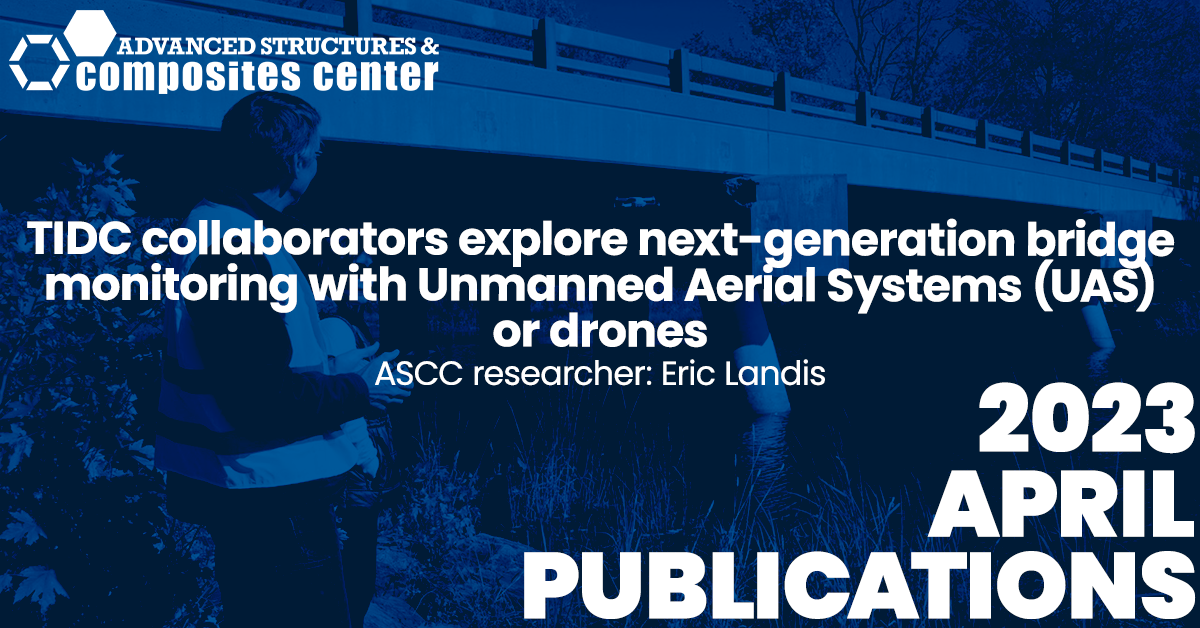
TIDC collaborators explore next-generation bridge monitoring with Unmanned Aerial Systems (UAS) or drones
Bridges are crucial infrastructure, connecting people and communities, and enabling economic growth. However, bridges are also subjected to natural wear and tear, which, if not managed correctly, can lead to structural deficiencies and threaten public safety. Thus, it is essential to evaluate and maintain the bridge’s health regularly. One key aspect of bridge health evaluation is the inspection of the underside, which can be challenging due to access difficulties and the lack of well-established techniques.
The authors represent researchers from the University of Maine, the University of Massachusettes Lowell, and the University of Vermont who are all a part of the Transportation Infrastructure Durability Center, collaborating on TIDC project C20.2020: “Advanced Sensing Technologies for Practical UAV-Based Condition Assessment” which was presented at the 2023 SPIE Smart Structures + Nondestructive Evaluation conference in Long Beach, California.
Their work, titled “Bridge deck underside evaluation with contacting and noncontacting UAS-mounted sensors” present a solution that could potentially revolutionize the way bridges are inspected. The authors propose using Unmanned Aerial Systems (UAS) or drones to inspect the undersides of bridges. UAS systems offer a supplement to conventional inspection methods that are difficult, expensive, and dangerous, such as snooper trucks or human inspection methods.
The paper describes a UAS system that can navigate on the underside of bridges and collect image data using onboard cameras. The image data is then evaluated using automated artificial intelligence methods, allowing the system to identify potential issues with the bridge’s health. Additionally, the system uses onboard nondestructive evaluation techniques, including noncontacting microwave radar and contacting acoustic response methods, to evaluate the bridge’s structural integrity.
Presented are results from experiments, data analysis, and signal processing, demonstrating the effectiveness of the proposed system. The authors believe that their proposed UAS system could significantly enhance the efficiency and accuracy of bridge inspections while also reducing risks associated with human inspection methods.
This innovative technology has the potential to revolutionize the way we inspect bridges and maintain their structural health. The proposed UAS system offers a safe, efficient, and effective method of inspecting the undersides of bridges, which will aid in identifying issues before they become major safety concerns. The development of this technology is a significant step forward in the field of bridge inspection and maintenance, and we can expect to see it being implemented in the near future.
Access the Conference Proceedings: Proceedings Volume 12487, Nondestructive Characterization and Monitoring of Advanced Materials, Aerospace, Civil Infrastructure, and Transportation XVII; 124870Y (2023) https://doi.org/10.1117/12.2666185
The TIDC is the 2018 U.S. DOT Region 1 University Transportation Center located within the University of Maine Advanced Structures & Composites Center. TIDC’s focus is on extending life and improving the durability of transportation assets. The University of Maine has partnered with The University of Connecticut, the University of Massachusetts Lowell, the University of Rhode Island, the University of Vermont, and Western New England University in collaboration with all 6 New England DOTs to create TIDC.
Contact: Taylor Ward, taylor.ward@composites.maine.edu
